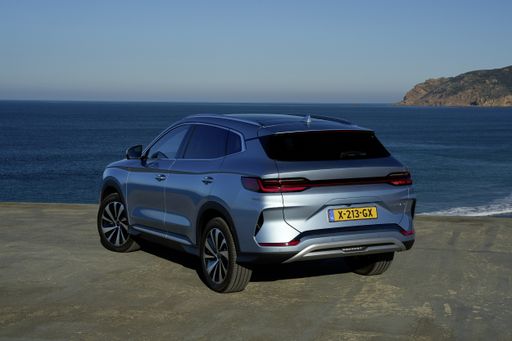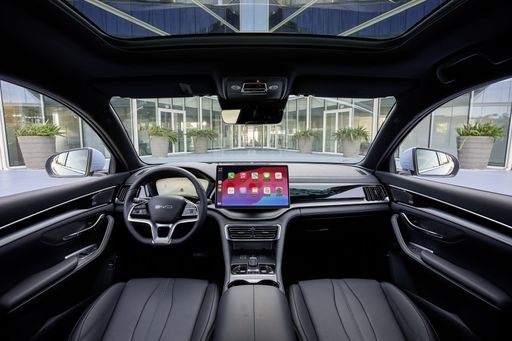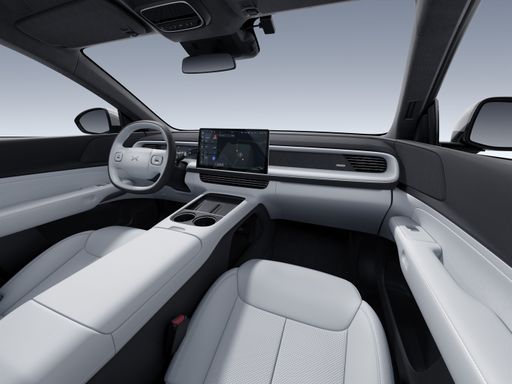As the automotive industry continues to evolve, two standout models from Chinese manufacturers are making headlines: the BYD Seal U and the XPeng G6. Both vehicles reflect the growing trend towards electrification and innovation in the SUV segment, but they cater to different consumer needs. In this article, we will compare these two electric SUVs in terms of their technical specifications, innovative features, and overall performance.
BYD Seal U vs XPeng G6 – Which car suits you better?
Everyday use, family trips or long-distance drives – here’s where the differences show.
Discover whether BYD Seal U or XPeng G6 fits your lifestyle better.
Technical Specifications Overview
The BYD Seal U is available in both plug-in hybrid and fully electric variants, offering consumers flexibility in their choice of powertrain. It boasts a maximum power output of 324 HP and can achieve a torque of up to 550 Nm, depending on the configuration. The SUV features both front-wheel and all-wheel-drive options, catering to varying requirements for traction and performance.
On the other hand, the XPeng G6 is exclusively electric and delivers a robust power output of 476 HP with an impressive torque of 660 Nm. The rear-wheel and all-wheel-drive configurations provide drivers with the choice of a sporty drive or a more practical, everyday utility. With a top speed of 200 km/h and an acceleration of merely 4.1 seconds from 0-100 km/h, the G6 is engineered for performance enthusiasts.
Electric Range and Efficiency
When it comes to electric range, the BYD Seal U offers several configurations with ranges varying from 70 km to an impressive 500 km. It operates with an energy consumption of about 19.9 kWh/100 km—a reasonable figure for a vehicle of its class. For those opting for its hybrid version, fuel consumption is remarkably low at 0.9 L/100 km, showcasing its efficiency.
The XPeng G6, however, takes the crown in terms of electric range, with figures reaching up to 570 km on a single charge. Its energy consumption is also commendable, at around 17.5 kWh/100 km, positioning it as one of the more efficient electric SUVs in the market.
Interior Space and Comfort
Both the BYD Seal U and XPeng G6 highlight spacious interiors that accommodate five passengers comfortably. The Seal U provides a trunk capacity of 425 to 552 liters, depending on the configuration, which is competitive in its class. The G6, however, slightly edges out its competitor with an impressive trunk capacity of 571 liters, making it an excellent option for families or those needing extra cargo space.
Innovative Features
In terms of tech and innovation, both models come equipped with cutting-edge features. The BYD Seal U integrates advanced driver assistance systems and a user-friendly infotainment system that keeps the driver connected while maintaining focus on the road.
Conversely, the XPeng G6 places a heavy emphasis on smart technology, with features like AI-powered voice control, an advanced smart navigation system, and autonomous driving capabilities. This positions the G6 as a leader in the tech-savvy market, catering particularly to younger, more tech-oriented consumers.
Conclusion: Which SUV to Choose?
Choosing between the BYD Seal U and XPeng G6 ultimately comes down to individual preferences. The Seal U offers hybrid versatility and solid performance, perfect for those needing a vehicle with flexible powertrain options. Meanwhile, the XPeng G6 stands out for its impressive electric range, cutting-edge technology, and high performance, appealing to those who are fully committed to electric driving.
As the automotive landscape continues to shift towards electrification, both the BYD Seal U and XPeng G6 highlight the exciting potential of innovative designs and technology in the SUV market. Whichever you choose, rest assured that both options deliver a blend of performance, efficiency, and modern features that are hard to beat.
Here’s where it gets real: The technical differences in detail
Costs and Efficiency:
When it comes to price and running costs, the biggest differences usually appear. This is often where you see which car fits your budget better in the long run.
BYD Seal U has a a bit advantage in terms of price – it starts at 34300 £, while the XPeng G6 costs 40800 £. That’s a price difference of around 6523 £.
In terms of energy consumption, the advantage goes to the XPeng G6: with 17.50 kWh per 100 km, it’s to a small extent more efficient than the BYD Seal U with 19.90 kWh. That’s a difference of about 2.40 kWh.
As for range, the XPeng G6 performs minimal better – achieving up to 525 km, about 25 km more than the BYD Seal U.
Engine and Performance:
Power, torque and acceleration say a lot about how a car feels on the road. This is where you see which model delivers more driving dynamics.
When it comes to engine power, the XPeng G6 has a clearly perceptible edge – offering 487 HP compared to 324 HP. That’s roughly 163 HP more horsepower.
In acceleration from 0 to 100 km/h, the XPeng G6 is decisively quicker – completing the sprint in 4.10 s, while the BYD Seal U takes 5.90 s. That’s about 1.80 s faster.
In terms of top speed, the XPeng G6 performs minimal better – reaching 200 km/h, while the BYD Seal U tops out at 180 km/h. The difference is around 20 km/h.
There’s also a difference in torque: XPeng G6 pulls slightly stronger with 660 Nm compared to 550 Nm. That’s about 110 Nm difference.
Space and Everyday Use:
Beyond pure performance, interior space and usability matter most in daily life. This is where you see which car is more practical and versatile.
Both vehicles offer seating for 5 people.
In curb weight, BYD Seal U is slight lighter – 1940 kg compared to 2115 kg. The difference is around 175 kg.
In terms of boot space, the XPeng G6 offers minimal more room – 571 L compared to 552 L. That’s a difference of about 19 L.
In maximum load capacity, the BYD Seal U performs slight better – up to 1465 L, which is about 91 L more than the XPeng G6.
When it comes to payload, XPeng G6 slightly takes the win – 475 kg compared to 410 kg. That’s a difference of about 65 kg.
Who comes out on top?
Overall, the XPeng G6 shows itself to be wins the duel decisively and secures the title of DriveDuel Champion.
It convinces with the more balanced overall package and proves to be the more versatile choice for everyday use.
 @ XPeng Motors
@ XPeng Motors
XPeng G6
BYD Seal U
The BYD Seal U presents itself as a sophisticated addition to the electric vehicle market, blending sleek design with cutting-edge technology. Its modern aesthetic is complemented by a spacious interior, offering both comfort and functionality for drivers and passengers alike. With advanced features prioritising sustainability and performance, it represents a bold step forward in eco-friendly motoring.
details @ BYD Auto / BYD Global Media
@ BYD Auto / BYD Global Media
 @ BYD Auto / BYD Global Media
@ BYD Auto / BYD Global Media
 @ BYD Auto / BYD Global Media
@ BYD Auto / BYD Global Media
XPeng G6
The XPeng G6 represents a bold leap forward in the realm of electric vehicles, combining sleek design with cutting-edge technology. This model offers an impressive range that makes it a formidable choice for long-distance travel, while its interior exudes sophistication and comfort. Additionally, advanced driver-assistance features ensure that the driving experience remains both safe and enjoyable, setting a new standard in automotive innovation.
details @ XPeng Motors
@ XPeng Motors
 @ XPeng Motors
@ XPeng Motors
 @ BYD Auto / BYD Global Media
@ BYD Auto / BYD Global Media
|
 @ XPeng Motors
@ XPeng Motors
|
|
|
|
Costs and Consumption |
|
|---|---|
|
Price
34300 - 39800 £
|
Price
40800 - 44200 £
|
|
Consumption L/100km
0.4 - 1.2 L
|
Consumption L/100km
-
|
|
Consumption kWh/100km
19.9 - 20.5 kWh
|
Consumption kWh/100km
17.5 - 18.4 kWh
|
|
Electric Range
70 - 500 km
|
Electric Range
510 - 525 km
|
|
Battery Capacity
-
|
Battery Capacity
80 kWh
|
|
co2
0 - 26 g/km
|
co2
0 g/km
|
|
Fuel tank capacity
60 L
|
Fuel tank capacity
-
|
Dimensions and Body |
|
|---|---|
|
Body Type
SUV
|
Body Type
SUV
|
|
Seats
5
|
Seats
5
|
|
Doors
5
|
Doors
5
|
|
Curb weight
1940 - 2147 kg
|
Curb weight
2115 - 2220 kg
|
|
Trunk capacity
425 - 552 L
|
Trunk capacity
571 L
|
|
Length
4775 - 4785 mm
|
Length
4758 mm
|
|
Width
1890 mm
|
Width
1920 mm
|
|
Height
1668 - 1670 mm
|
Height
1650 mm
|
|
Max trunk capacity
1440 - 1465 L
|
Max trunk capacity
1374 L
|
|
Payload
410 kg
|
Payload
470 - 475 kg
|
Engine and Performance |
|
|---|---|
|
Engine Type
Plugin Hybrid, Electric
|
Engine Type
Electric
|
|
Transmission
Automatic
|
Transmission
Automatic
|
|
Transmission Detail
CVT, Reduction Gearbox
|
Transmission Detail
Reduction Gearbox
|
|
Drive Type
Front-Wheel Drive, All-Wheel Drive
|
Drive Type
Rear-Wheel Drive, All-Wheel Drive
|
|
Power HP
218 - 324 HP
|
Power HP
296 - 487 HP
|
|
Acceleration 0-100km/h
5.9 - 9.6 s
|
Acceleration 0-100km/h
4.1 - 6.7 s
|
|
Max Speed
170 - 180 km/h
|
Max Speed
200 km/h
|
|
Torque
300 - 550 Nm
|
Torque
440 - 660 Nm
|
|
Number of Cylinders
4
|
Number of Cylinders
-
|
|
Power kW
160 - 238 kW
|
Power kW
218 - 358 kW
|
|
Engine capacity
1497 - 1498 cm3
|
Engine capacity
-
|
General |
|
|---|---|
|
Model Year
2024
|
Model Year
2025
|
|
CO2 Efficiency Class
B, A
|
CO2 Efficiency Class
A
|
|
Brand
BYD
|
Brand
XPeng
|
What drive types are available for the BYD Seal U?
The BYD Seal U is available as Front-Wheel Drive or All-Wheel Drive.
The prices and data displayed are estimates based on German list prices and may vary by country. This information is not legally binding.
